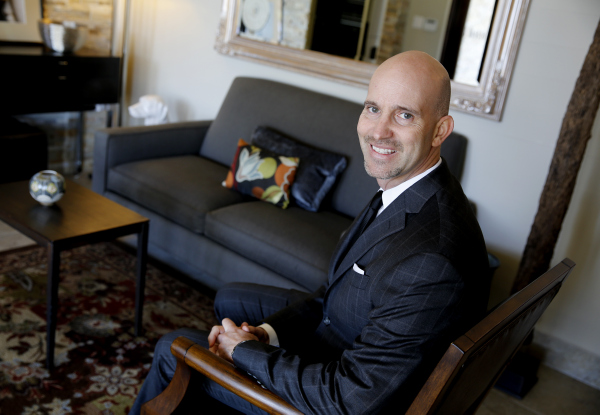By KATIE WATTS / Petaluma Towns Correspondent
Jeff Lyons is talking about trends in the industry. Home funerals. Pet funerals. Green burials. Wildcat ash scattering.
The 46-year-old owner-director of Adobe Creek Funeral Home sees them all as he helps ease clients through painful times.
Unlike the old style funeral director who set the course, which Lyons describes as a cookie-cutter method, “now we let them lead us, although we can guide them.
“This is a difficult time. It’s grief, and it takes time, but they can come through it and say, ‘We did the right thing’ and get some closure.”
Lyons began working in the funeral industry while still in high school, mowing lawns and tending flowers at a nearby mortuary. Over time he began working with families.
“I felt that connection with them and knew this was it,” he says. “I wanted to help people.”
In 1989, Lyons moved to San Francisco to attend the San Francisco College of Mortuary Science, which he calls the best in the country. He worked at several funeral homes before moving to the North Bay.
“I got my licensing, passed the boards and worked for another funeral home in the area before I branched out in 1998 with Kirk Cheda and we started our own,” he says.
He and Cheda bought Pleasant Hills Memorial Park Mortuary and Crematory in Sebastopol in 2003. “The owner asked if we wanted to buy,” Lyons says. “We had been considering putting in a crematory, but they already had one.”
In 2010, Cheda left Adobe Creek, leaving Lyons as sole owner. The business now serves Sonoma and Marin counties as well as families in San Francisco and the Napa area.
Cremation often figures into the equation, with 42 percent of Americans choosing that option, 61 percent in California and other Pacific states, according to the Cremation Association of North America. Those numbers jump to nearly 90 percent in Marin County, according to U.S. Funerals Online.
“Regardless of whether they choose cremation or burial, families are doing more personal services,” Lyons says. For example, Adobe Creek supplies audio-video equipment for video tributes that have become “hugely popular.”
Another trend is a move away from funeral homes. Some people “embrace natural death care, basically home funerals,” he says. Final Passages, a leader in this movement also known as the Natural Death Care Project, is headquartered in Sebastopol.
“We help any way we can,” Lyons says. “We do the cremation. Then, as they did years ago, the family gathers in the house. After the service, the funeral home or natural death care people handle the transfer.”
Another huge movement involves natural burials, Lyons says, for people who want to be green and care for the Earth, even after death.
“They’ve opened a green burial area in Sebastopol,” he says. “We use no vault, no liner, often no casket, just a shrouded body placed in the grave.”
People also want help caring for and grieving their departed pets, a process often trivialized or misunderstood, Lyons says.
“We’re opening a pet section at Pleasant Hills, we had so many requests. Pets are so often members of the family. You have this animal who is part of your life and when it dies, it’s so hard. This can bring comfort. It’s a huge segment of the market. ”
And then there is the issue of wildcat scatterings, when families take ashes and scatter them at places the departed relative cared about. What if the person asked to have his ashes left on the pitcher’s mound at AT&T Park, tossed off Space Mountain in Disneyland or sifted along the track at Petaluma High School?
“We advise people of the rules and regulations of the state of California,” Lyons says, “but people do this all the time. What they choose to do with ashes is their own business and rightly so. We don’t dictate that, and we shouldn’t.”
Costs can be significantly lower with cremation, about $1,100 for a basic, immediate cremation at Adobe Creek, for example, compared with up to $3,895 for a traditional funeral, casket not included.
Lyons notes that some funeral homes are slow to accept the changes, but to him it’s “just another aspect of death care. How can we not grow with the times? It’s changing, we’re changing with it, and I absolutely like the change.”
The bottom line, he emphasizes, is that one thing never changes. “It’s still families coming to see us because they’ve lost someone they love.”
Do people react oddly when they learn what his profession is?
“Very few,” Lyons says. “You might think no one would want to talk about it, but because it’s a basic human experience that everyone does, we hear such great stories. That’s what it’s about, learning about the people and their history, even if it’s not always about people you helped.”
Lyons acknowledges that his job can be emotionally difficult, “especially with children, which is devastating. The family is shattered. Hopefully, you can help them stand and walk forward.”
More than anything, he says, being in the funeral industry has taught him one lesson.
“Live life to the fullest, because every day you see it taken away. Each day is precious.”

